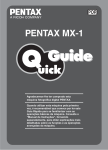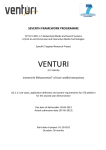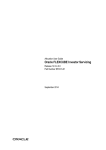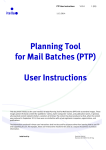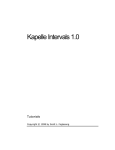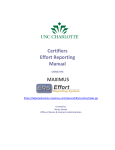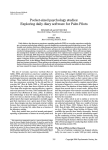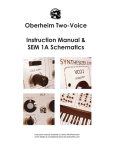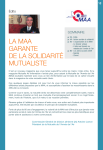Download Kids and Cookies
Transcript
Kids and Cookies User Manual Brian Sharp Game Created by: Leah Garofalo Development: Joe Garofalo and Brian Sharp Programming: Tim Summers Graphic Design: Starrie Williamson http//:www.teacherlink.org Table of Contents 1. What is Kids and Cookies? 2. A Tour of Kids and Cookies a. Kid selection screen b. Cookie selection screen c. Snack table screen d. Menu bar 3. Types of Cookie Sharing Tasks a. Fair sharing tasks b. Did I share fairly? c. How many cookies were in the bin? d. Paper cutout tasks 4. Kids and Cookies and Rational Number Research a. Developmental stages of partitioning abilities b. Distribution strategies 5. Conclusion and Contact Information Section 1: What is Kids and Cookies? Kids and Cookies is a Flash-based program designed to build upon children’s informal concepts of rational numbers. The problem-solving context of the game is familiar to all children – How can a host share cookies fairly among friends? This context allows for the connection of fraction concepts (e.g., partitioning, equivalence classes, and unit) and authentic problem solving situations. The design of Kids and Cookies makes the program versatile enough to accommodate differing ability levels. By manipulating features of the program, parents and teachers can gain insights into student thought processes and methods for solving tasks. The program also incorporates multiple representations of fractions into the problem solving tasks. Area models, numerical symbols, and voice ques are all a part of the program. Players can control the types of representations displayed through option menus. Section 2: A Tour of Kids and Cookies Kids and Cookies has three main screens and a menu bar. The three screens are the kid and cookie selection screen and the snack table screen. The menu bar contains buttons that control the options of the program as well as links to resources such as cutout figures of kids and cookies. The Kid and Cookie Selection Screen The kid selection area contains eight images of kids. A player can select up to six kids to seat at the snack table. When the player selects a kid, a gold highlight surrounds the chosen kid and a counter keeps a running count of the number of kids chosen. Figure 1 shows three kids selected for seating at the snack table. Figure 1. The kid and cookie selection screen. The cookie selection area allows the player to select from one to ten cookies to share among kids seated at the snack table. Cookies are chocolate (rectangular) or oatmeal (circular). Toggle buttons below the cookies control the type of cookies. As with the kid selection, a gold highlight surrounds the chosen cookies and a counter keeps a running count of the number of cookies chosen. Figure 1 shows six oatmeal cookies selected for distribution. The Snack Table Screen The snack table screen is the main interface of Kids and Cookies. This is the place where players partition and distribute cookies to the kids. Starting near the bottom of the screen (see Figure 2), there is an area called the ‘cookie bin.’ This is where cookies are initially stored before distribution. Cutting board Cookie cutters Cookie bin Outline toggle switch Figure2. The snack table screen. To the right of the cookie bin is an orange toggle switch that places (or removes) ‘outlines’ around the cookies in the cookie bin. Outlines are sometimes a useful way to help players remember how many cookies were originally in the cookie bin. Outlines also serve as a way to verify solutions during reconstitution tasks. Above the cookie bin is an area labeled the ‘cutting board.’ When a player wants to partition a cookie, they first drag the cookie to the cutting board. Once the player places a cookie on the cutting board, six ‘cookie cutters’ change from gray (inactive) to gold (active) in color. The player then clicks on the desired cutter which results in a partitioned cookie. The player can then move one piece of the cookie at a time to the snack table. In the event that a player wants to reconstitute a partitioned cookie into a whole cookie, he or she can place a piece of the partitioned cookie on the cutting board. At that point, only one cutter, the ‘whole’ cutter, is activated. By clicking on the whole cutter, the player meshes all the pieces of the partitioned cookie into a whole cookie. Another way that players can combine cookie pieces is by using the ‘Join’ feature (see Figure 3). When a player moves a cookie piece close to a cookie piece that is already on the snack table, the word ‘Join’ appears. If the player releases the cookie piece while ‘Join’ is pulsating, the two pieces will combine, as long as the sum of the two pieces is not more than a whole cookie. Figure 3. The joining of two cookie pieces. When a player selects the orange “tally” button (see Figure 4) at the right of the screen, the numerical symbol for each cookie piece is displayed below each kid. This feature is useful for helping children compare ½ to ¼ + ¼. Figure 4. Using the tally feature to compare ½ to ¼ + ¼. To the right of the cookie cutters are two buttons labeled ‘put one back’ and ‘put all back.’ These buttons allow a player to return one cookie at a time to the cookie bin, or simultaneously return all of the cookies to the cookie bin. In the event that a player selects the “put one back” button, the most recently manipulated cookie, not currently in the cookie bin, returns to the cookie bin. Above the cookie cutters is the snack table. The snack table colors alternate between two shades of tan. The shaded areas define where a player can place a cookie for each kid. If a player places a cookie outside these defined areas, the cookie returns to its previous position. Once a player distributes all the cookies, he or she can check to see if they shared the cookies fairly by selecting the ‘eat cookies’ button. A voice que gives the player feedback as to whether or not the distribution was fair. The player then has the option of returning to the current game, starting a new game, or quitting the program. The Menu Bar The menu bar consists of six pull-down menus: game, sound, view, symbols, change, and other. These menus contain options that allow a player, teacher or other game administrator to tailor the game to focus on specific learning objectives. The ‘game menu’ allows a player to quit or start a new game. The ‘sounds menu’ allows a player to turn on or off such options as voice ques for fraction names, verbal directions, and music. The player can also control the volume of these sounds. Since the voice ques state the size of a selected cookie piece, it is advantageous to have the sound turned off in certain situations. The ‘view menu’ allows players to change the size of the viewing window. The two choices are full screen and 640 by 480. The full screen option makes the game cover the entire screen, which eliminates the distractions caused by multiple open windows. The 640 by 480 option is convenient when a player wants to maneuver between multiple windows. Options under the ‘symbols menu’ allow a player to turn on or off fraction symbols. When a player turns on this option, fraction symbols shadow whichever cookie piece the player is moving, giving the piece’s size relative to a whole cookie. Fraction symbols also depict how much of a whole cookie remains on the cutting board. See Figure 5. Fraction symbol shadows a cookie piece Fraction symbol depicts how much of a whole cookie remains on the cutting board Figure 5. Fraction symbols option turned on. Players have three options available under the ‘change menu.’ They can change the number or type of kids seated at the snack table, they can change the number or type of cookies, or they can chose which cutters they want to make available for the game without having to reset the game. The cutter selection option is particularly useful. By making certain cutters unavailable, the parent or teacher can force a player to find alternate solution strategies to certain tasks. The ‘other menu’ contains credit and contact information, as well as, links to files containing images of all the kids and cookie types. Parents and teachers can print off these image files and have their students play Kids and Cookies with paper cutouts. Parents and teachers can also use paper cutouts to set up problem solving tasks for their students that are beyond the scope of the software. Section 3 describes some of these tasks. Section 3: Types of Cookie Sharing Tasks We originally designed Kids and Cookies so parents and teachers could engage their students in fair sharing tasks. However, after working with several children from grades Pre-K to 3, we started seeing other ways that Kids and Cookies can help develop division and fraction knowledge. This section details the utility of Kids and Cookies. Fair Sharing Tasks In our research, we looked at children solving various ‘fair sharing’ tasks. We outline these tasks in Figure 6. When having children solve fair sharing tasks, it is important that they experience as many different types of tasks as possible. Teachers should encourage children to solve tasks using several methods and talk about the strengths and weaknesses of each method. For example, if the task is to share one cookie among three kids, a strategy children might use to solve the task is to cut the cookie into three pieces and distribute one-third cookie to each kid. Another method children might use to solve the task is to cut the cookie into six pieces and distribute two-sixths cookie to each kid. Children might prefer one strategy over another based on the size of the cookie pieces, the amount of time it takes to distribute the pieces, or other reasons. Types of fair sharing tasks The number of cookies, C, is a multiple, n, of the number of kids, K. C = nK Examples 6 cookies and 3 kids 8 cookies and 4 kids 4 cookies and 2 kids The number of cookies exceeds the number of kids by one. C = K+1 5 cookies and 4 kids 3 cookies and 2 kids 7 cookies and 6 kids The number of cookies exceeds the number of kids by more than one. C > K+1 5 cookies and 3 kids 9 cookies and 6 kids 7 cookies and 5 kids The number of cookies is less than the number of kids. C<K 1 cookie and 3 kids 4 cookies and 6 kids 2 cookies and 5 kids Eliminate the cutter that cuts a cookie into K pieces. 1 cookie and 3 kids (no thirds cutter) 4 cookies and 6 kids (no sixths cutter) 2 cookies and 4 kids (no fourths cutter) Figure 6. Various fair sharing tasks. A good starting point for parents and teachers to introduce Kids and Cookies is to have students solve tasks where the number of cookies is an integral multiple of the number of kids (see Figure 7). All of the children in our research, including four year olds, could solve tasks of this type. Figure 7. A task where the number of cookies is an integral multiple (e.g., six cookies and three kids) of the number of kids. The children demonstrated two distinct ways to distribute cookies. Some children dealt out cookies one at a time to each kid in rotation until they exhausted the cookie supply (see Figure 8). Figure 8. A one to one distribution method Other children figured out in advance the number of cookies each kid should receive and then dealt out the cookies in a “many to one” fashion (see Figure 9). Figure 9. A many to one distribution method. Another type of task is to have children share one cookie among a group of friends. This gives children experience working with unit fractions. When solving tasks of this nature, most children will count the number of kids at the snack table and then start counting pieces in each cutter until they find the cutter that contains the same number of pieces as kids. We labeled this technique as the “number of kids equals the number of pieces” strategy (see Figure 10). Figure 10. The “number of kids equals the number of pieces” strategy One child in our study, however, preferred using cutters that yielded more pieces than the number of kids at the snack table (see Figure 11). He reasoned that if a kid had more pieces of the cookie, the kid could eat some cookie pieces now and save some pieces to eat later. We titled this the “many pieces” strategy. Figure 11. Using the “many pieces” strategy to share one cookie among three kids. To give children experience working with fractions larger than one, they should work with tasks where the number of cookies is larger than the number of kids (e.g., five cookies and three kids). With tasks like these, some children will distribute whole cookies first, and then partition the remaining cookies. In our research, we found children who enjoyed cutting cookies and chose to cut more cookies than necessary to solve the tasks (e. g., cutting all cookies when some whole cookies could be distributed). In the case of sharing five cookies among three kids, children often state that each kid receives one whole and two one-thirds cookie because the one-third pieces are vertically aligned (see Figure 12). Here the join feature might help children understand that one whole and two one-thirds cookie is equivalent to one whole and two-thirds cookie. Figure 12. Five cookies shared among three kids. In our research, we found that one of the hardest types of tasks for children to solve were tasks where the number of cookies was less than the number of kids and the cutter that yielded the same number of cookie pieces as the number of kids was eliminated (e.g., four cookies and six kids with no sixths cutter available). Tasks of this type force children to consider strategies besides the “number of kids equals the number of pieces” strategy. Some children in our research used number facts like 3 + 3 = 6 to help them solve tasks of this type. They reasoned that since they couldn’t cut one cookie to yield six pieces (the number of kids), then they needed to cut two cookies to yield six pieces. They knew that 3 + 3 = 6, so they cut each cookie into thirds and distributed onethird cookie to each kid. They repeated this process for the remaining two cookies. “Did I Share Fairly?” In these tasks, parents or teachers distribute cookies before they allow children to see the snack table (see Figure 13). Children are then asked to determine if the solution is fair. Tasks of this type force children to use the shape of the cookie pieces in formulating their answers. After children decide on their answer, they can check the correctness of their answer by selecting the ‘eat’ button. These tasks also give children experience working with the concept of equivalent fractions. For example, in the task shown in Figure 13, children have to determine if two one-half cookie pieces are equivalent to three one-third pieces, two one-fourth pieces and a one-half piece, and one whole cookie. Figure 13. Were the cookies shared fairly? How Many Cookies Were in the Bin? As an addition to the “Did I share fairly” tasks, parents and teachers can ask children how many cookies were originally in the cookie bin (see Figure 14), making sure the outline feature is turned off. After children decide on their answer, they can check the correctness of their answer by selecting the ‘outline’ button. Figure 14. How many cookies were in the cookie bin (outline on)? Paper Cutout Tasks The paper cutouts of kids and cookies are useful for a variety of reasons. During some of our interviews, we used the paper cutouts in a pre-test/post-test fashion where we considered Kids and Cookies as an intervention. At the beginning of the interview, we presented children with tasks similar to those we gave them within the Kids and Cookies environment. Often, children had difficulty marking and cutting cookies in such a way that fair shares resulted in their distributions. In particular, the task of sharing one round cookie among three kids was difficult for most children to complete correctly. At the end of the interview, after children completed the pre-test and Kids and Cookies intervention, we gave the children a post-test similar to the pre-test. We found that some children solved the tasks we presented them in very different ways compared to their pre-test methods. During the post-test, most children were able to solve the task of sharing one round cookie among three kids by making three radial cuts in the cookie. Children never used radial during the pre-test in our interviews. The paper cutouts also allow teachers to give children tasks that we call “tent tasks.” The following is a typical tent task scenario. Leah and some of her friends went camping. During the night the campers decided that they needed a snack. Leah remembered that she had a large cookie in her bag out side the tent. She decided to share the cookie with hers friends. Assuming that Leah shared the cookie fairly, look at the setting (Figure 15 in this case) and decide how many friends were in the tent? Figure 15. A tent problem setup. When solving tent tasks, children sometimes recognize the size of the cookie piece. This means that they know which iconic representations match up to which fractions. For example in Figure 15, a child may recognize that the cookie piece matches up with the iconic representation of one third. Another way that children might choose to solve a tent task is to rotate the cookie piece around its center. Children using this method try to see how many ‘copies’ of the piece is required to fill in a full circle. Section 4: Kids and Cookies and Rational Number Research Developmental Stages of Partitioning Abilities Piaget, Inhelder, and Szeminska (1960) conducted research on children’s sharing strategies. The children, who were between the ages of 4 and 9, were shown a number of clay cakes and a number of dolls. The children were given a wooden knife to use in cutting the clay cakes. The researchers told the children that the dolls are going “to eat up all the cake, but they’ve got to have exactly the same amount as each other: how shall we do it (p.241)?” The researchers found that as the children aged, they progressed through three stages of development with respect to partitioning tasks. At the beginning of Stage 1, usually referring to children between the ages of 4 years 0 months and 4 years 6 months, children have difficulty dividing a cake into halves to share between two dolls. Children at this stage often do not share the entire cake, cut the cake into many pieces and distribute the pieces in an unequal manner, or cut the cake into three pieces, believing that the number of cuts equals the number of pieces obtained. During Stage 2, usually between the ages of 4 years 6 months and 6 years 0 months, children can solve problems involving halves and fourths. They also tend to be able to solve problems involving thirds (e.g., one cake and three dolls), but have difficulty dividing a whole into fifths. Conservation of the whole is realized intuitively, but not operationally. When children reach Stage 3, they understand the relationship between the fractions to be realized and the original whole. They are able to employ anticipatory schema (i.e., mentally mapping out a solution strategy without physically experimenting with the manipulatives) and deal successfully with divisions into fifths and sixths. Piaget et al. (1960), concluded, Before parts can be equated in conformity with the extensive characteristics of fractions, they must first be constructed as integral parts of a whole which can be decomposed and also reassembled. Once that notion of part has been constructed it is comparatively easy to equate the several parts. Therefore, while the elaboration of operations of subdivision is a lengthy process, the concept of a fraction follows closely on that of a part (p. 335). Pothier and Sawada (1983) studied 43 children in grades K-3. From their study they proposed a five-level theory to describe the development of the partitioning process. At Level 1, the sharing level, children begin to learn how to partition an object using a median-cut line to produce halves and fourths. Sometimes the resulting pieces are uneven and often more pieces are produced than is necessary to complete the sharing task. Children functioning at this level see partitioning continuous quantities as allocating pieces. A “fair share” refers to an equal number of pieces, regardless of the size of each piece. At Level 2, the algorithmic halving level, children are able to partition circular and rectangular regions into fractional parts whose denominator are powers of 2. This is accomplished by repeatedly bisecting each part in turn. At this level there is still no concern for equality. Level 3, the evenness level, is attained when children start considering the size and shape of the parts to determine fair shares. Partitioning a region into fourths, bisecting two of the sections, and then readjusting the partition boundaries allows the child to obtain six equally-sized parts (sixths). Using the same type of geometric motion, fractions with even denominators can be produced. Level 4 is called the oddness level. Children reach this level when they discover that partitioning regions using a median cut does not produce certain fractional parts like thirds or fifths. To produce an odd number of parts, children use a counting algorithm to guide their partitioning. They produce pieces one by one from the whole by cutting from the center of the cake to the edge (i.e., radial cuts). Frequent readjustments are necessary. The final level, Level 5, is the composition level. When the region is to be partitioned into ninths or another large odd number of pieces, the method used in Level 4 can be problematic. A more efficient method is to break a composite number, say n, down into factors, say x and y such that xy = n. The desired number of pieces, n, can then be obtained by first partitioning the region into x pieces, and then partitioning each of these pieces into y parts. For example, to partition a cake into twelfths a child could partition the cake into sixths and then cut each of those pieces in half. Pothier and Sawada did not observe children at this level in their research, but they contend that the use of composite number facts is the next logical step in the development of partitioning strategies. Children in our work displayed some behaviors consistent with the developmental levels described by the aforementioned researchers. For example, when a first grader was shown the screen depicted in Figure 13 and asked if the four kids received the same amount of cookies, she responded by saying that some kids had more cookies than other kids. She was counting cookie pieces, but not attending to the size of the pieces or how the pieces related to a whole cookie. However, after using the “join” feature to combine cookie pieces, she solved the task correctly. A third grader had difficulty solving a “paper cut out” task where he had to divide one cookie among three kids. He made several attempts to solve the task using an “algorithmic having technique” similar to the technique described by Pothier and Sawada. This method did not lead to a successful solution to the tasks. However, when he revisited the task after using the software, he dissected the cookie into thirds using three radial cuts. Most children in our work employed some sort of anticipatory schema to help them solve at least a portion of the tasks. These schemas ranged from simple mental “dealing out” procedures to more sophisticated procedures that utilized number facts. Distribution Strategies Several researchers have sought to identify the strategies children use to distribute items among friends. Hunting and Sharpley (1991) found that preschool children, ages 3 to 4, were able to share 12 crackers among 3 dolls using a variety of distribution strategies. The most common strategy used can be described as a one-to-one distribution strategy. Using this procedure, children dealt out a single cracker to each doll in turn. Children repeated the cycle until all twelve crackers were given out. A more efficient variation of this procedure was a many-to-one allocation of crackers to dolls for at least one cycle. The most common many-to-one methods were an initial allocation of lots of three crackers followed by an allocation of a single cracker, and an initial allocation of lots of two crackers followed by two cycles of single crackers. Children observed to use non-systematic procedures would allot crackers to dolls either one at a time, but not in rotation, or place crackers sometimes two at a time, sometimes one at a time. Eleven percent of the children used non-systematic methods to arrive at equal shares. Twenty-seven percent of the children who used non-systematic methods produced unequal shares. Our findings were similar to those found by Hunting and Sharpley. We had some children who used a one to one dealing out strategy (see Figure 8), we had some children who used a many to one dealing out strategy (see Figure 9), and we had some children who used non-systematic procedures. After working on several Kids and Cookies tasks, some children who used a one to one dealing out strategy switched to a many to one dealing out strategy. The software, however, only allows one cookie piece at a time to be distributed, so some users may not have seen any benefit to changing strategies. A study by Lamon (1996) looked at 346 students in grades 4 through 8. In her study, students were presented with eleven tasks in which they were asked to draw pictures to show how they would share various types of foods among given numbers of people. Lamon found that children as young as 4th grade had the capacity to dissect and distribute food equally to a given number of people. She also noted a general trend in the methods used by the children depending upon their age. The younger children were more likely to dissect food in an uneconomical manner (cutting a cookie into sixths when thirds would suffice), and then distributing singletons among the people, while older children in the study were more likely to dissect food in an economical manner. Some students used a mixed approach where they dissected the food in an uneconomical manner, but distributed composites of food among the people. Her research revealed at least four dimensions along which strategies could be differentiated: (1) preservation of pieces that did not require cutting in cases where each person receives more than one object in a discrete quantity, (2) economy of the marking (not using sixths when thirds would suffice), (3) economy of the cutting (not making more cuts than necessary), and (4) the nature, packaging, and social practices related to the objects being shared. Lamon’s research also revealed that the social factors and practices surrounding the type of shared food greatly influenced the methods of sharing. Students were not worried about cutting pizza economically, but were worried about cutting cookies economically. One reason for this difference was that children thought that cookies were more likely to crumble than pizzas, so fewer cuts would be desirable. Some children in our work were concerned with economy. For example, a second grader wanted to distribute the largest pieces possible to the kids, so he started each task by determining if he could use the halves cutter to solve the task. Some children in our work enjoyed the act of cutting cookies and moving pieces. Therefore, economy of cutting and preservation of pieces did not concern them. They cut cookies into many pieces so they would have more opportunities to use the mouse. Sometimes we forced these children to consider larger cookie pieces by turning off certain cutter options. When the cutters were turned off, children sometimes resorted to a number facts strategy (as described in Section 3) to help them solve the task. Social practices also played a part in solution methods. Some children did not like to cut cookies into small pieces because “it wouldn’t be right to give out such small pieces.” As mentioned before, one child used a many pieces strategy so the kids could save some of the cookie pieces to eat at a later time. When comparing the results of previous research to the actions of children using Kids and Cookies, care must be taken. Most of the research mentioned in this section dealt with children partitioning cookies (or cookie models) with plastic knives or scissors. Children in these studies had an infinite number of ways in which to partition the cookies. Since Kids and Cookies is a computer program, it is more discrete in nature; therefore children are somewhat limited in their actions. However, the software environment allows for other features to be incorporated into the partitioning tasks such as sounds and symbols. The bottom line is that when you use Kids and Cookies be aware of the strengths and limitations of the program. Section 5: Conclusion and Contact Information We are continually developing new ways to use Kids and Cookies to facilitate the learning of division and fraction concepts in children. If you have ideas for tasks, for software modifications, or for the addition of new features, please drop us an email. You can send your comments and ideas to [email protected]. References Hunting, R. & Sharpley, C. (1988). Preschoolers cognitions of fraction units. The British Journal of Educational Psychology, 58, 172-183. Lamon, S. (1996). The development of unitizing: Its role in children’s partitioning strategies. Journal for Research in Mathematics Education, 27, 170-193. Mack, N. (1995). Confounding whole-number and fraction concepts when building on informal knowledge. Journal for Research in Mathematics Education,26, 422-441. Piaget, J., Inhelder, B., & Szeminska, A. (1960). The child’s concept of geometry. New York: Basic Books. Pothier, Y. & Sawada, D. (1983). Partitioning: the emergence of rational number ideas in young children. Journal for Research in Mathematics Education, 14(4). (pp. 307317).





























